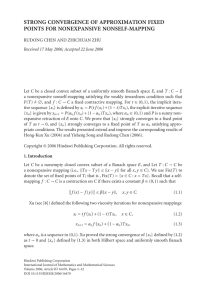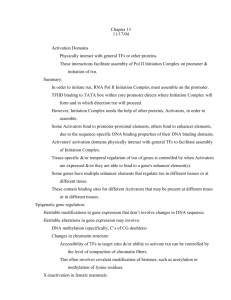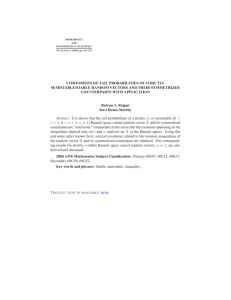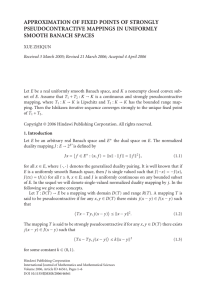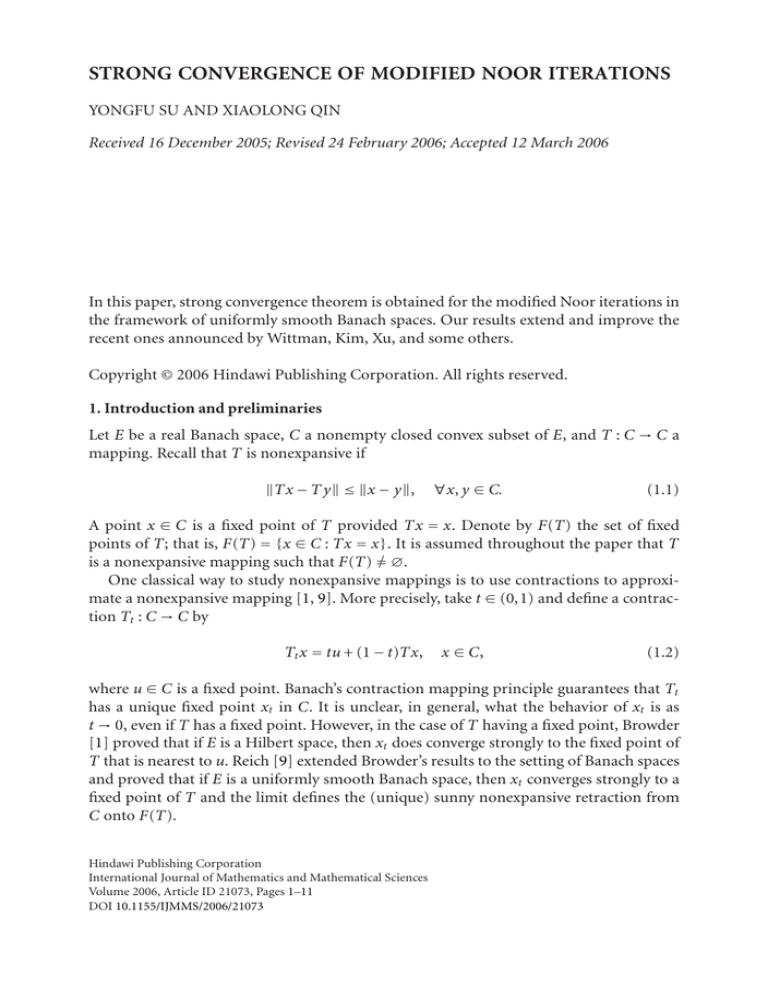
STRONG CONVERGENCE OF MODIFIED NOOR ITERATIONS
YONGFU SU AND XIAOLONG QIN
Received 16 December 2005; Revised 24 February 2006; Accepted 12 March 2006
In this paper, strong convergence theorem is obtained for the modified Noor iterations in
the framework of uniformly smooth Banach spaces. Our results extend and improve the
recent ones announced by Wittman, Kim, Xu, and some others.
Copyright © 2006 Hindawi Publishing Corporation. All rights reserved.
1. Introduction and preliminaries
Let E be a real Banach space, C a nonempty closed convex subset of E, and T : C → C a
mapping. Recall that T is nonexpansive if
Tx − T y ≤ x − y ,
∀x, y ∈ C.
(1.1)
A point x ∈ C is a fixed point of T provided Tx = x. Denote by F(T) the set of fixed
points of T; that is, F(T) = {x ∈ C : Tx = x}. It is assumed throughout the paper that T
is a nonexpansive mapping such that F(T) = ∅.
One classical way to study nonexpansive mappings is to use contractions to approximate a nonexpansive mapping [1, 9]. More precisely, take t ∈ (0,1) and define a contraction Tt : C → C by
Tt x = tu + (1 − t)Tx,
x ∈ C,
(1.2)
where u ∈ C is a fixed point. Banach’s contraction mapping principle guarantees that Tt
has a unique fixed point xt in C. It is unclear, in general, what the behavior of xt is as
t → 0, even if T has a fixed point. However, in the case of T having a fixed point, Browder
[1] proved that if E is a Hilbert space, then xt does converge strongly to the fixed point of
T that is nearest to u. Reich [9] extended Browder’s results to the setting of Banach spaces
and proved that if E is a uniformly smooth Banach space, then xt converges strongly to a
fixed point of T and the limit defines the (unique) sunny nonexpansive retraction from
C onto F(T).
Hindawi Publishing Corporation
International Journal of Mathematics and Mathematical Sciences
Volume 2006, Article ID 21073, Pages 1–11
DOI 10.1155/IJMMS/2006/21073
2
Nonexpansive mapping
Halpern [5] firstly introduced this iteration scheme:
x0 = x ∈ C
xn+1 = αn u + 1 − αn Txn ;
arbitrarily,
(1.3)
see also Browder [2]. He pointed out that the conditions limn→∞ αn = 0 and ∞
n=1 αn = ∞
are necessary in the sense that if the iteration scheme (1.3) converges to a fixed point of T,
then these conditions must be satisfied. Ten years later, Lions [7] investigated the general
case in Hilbert space under the conditions
lim αn = 0,
n→∞
∞
n =1
αn = ∞,
lim
n→∞
αn − αn+1
=0
α2n+1
(1.4)
on the parameters. However, Lions’ conditions on the parameters were more restrictive
and did not include the natural candidate {αn = 1/n}. Reich [9] gave the iteration scheme
(1.3) in the case when E is uniformly smooth and αn = n−δ with 0 < δ < 1.
Wittmann [11] studied the iteration scheme (1.3) in the case when E is a Hilbert space
and {αn } satisfies
∞
lim αn = 0,
n→∞
n =1
αn = ∞,
∞
αn+1 − αn < ∞.
(1.5)
n =1
Reich [10] obtained a strong convergence of the iterates (1.3) with two necessary and
decreasing conditions on parameters for convergence in the case when E is uniformly
smooth with a weakly continuous duality mapping.
This paper introduces the composite iteration scheme:
wn = δn xn + 1 − δn Txn ,
zn = γn xn + 1 − γn Twn ,
yn = βn xn + 1 − βn Tzn ,
xn+1 = αn u + 1 − αn yn ,
(1.6)
where u ∈ C is an arbitrary (but fixed) element in C, and {αn }, {βn }, {γn }, and {δn } are
sequences in (0,1). We prove, under certain appropriate assumptions on the sequences
{αn }, {βn }, {γn }, and {δn } that {xn } defined by (1.6) converges to a fixed point of T.
If δn = 1 in (1.6), then iterative scheme (1.6) is a modified Ishikawa iteration:
zn = γn xn + 1 − γn Txn ,
yn = βn xn + 1 − βn Tzn ,
xn+1 = αn u + 1 − αn yn .
(1.7)
If γn = 1 in (1.6), then iterative scheme (1.6) is a modified Mann iteration:
yn = βn xn + 1 − βn Txn ,
xn+1 = αn u + 1 − αn yn .
(1.8)
If γn = 1 and βn = 0 in (1.6), then iterative scheme (1.6) is a usual Halpern iteration
defined by (1.3).
Kim and Xu [6] proved the iteration scheme (1.8) converges to fixed point of T in
uniformly smooth Banach spaces.
It is our purpose in this paper to introduce composite iteration scheme (1.6) for
approximating a fixed point of nonexpansive mappings in the framework of uniformly
Y. Su and X. Qin 3
smooth Banach spaces; we establish the strong convergence of the composite iteration
scheme {xn } defined by (1.6). The results improve and extend results of Kim and Xu [6],
Wittmann [11], and others.
Let E be a real Banach space and let J denote the normalized duality mapping from E
∗
into 2E given by
J(x) = f ∈ E∗ : x, f = x2 = f 2 ,
x ∈ E,
(1.9)
where E∗ denotes the dual space of E and ·, · denotes the generalized duality pairing.
The norm of E is said to be Gâteaux differentiable (and E is said to be smooth) if
lim
x + t y − x (1.10)
t
t →0
exists for each x, y in its unit sphere U = {x ∈ E : x = 1}. It is said to be uniformly
Fréchet differentiable (and E is said to be uniformly smooth) if the limit in (1.10) is
attained uniformly for (x, y) ∈ U × U.
We need the following definitions and lemmas for the proof of our main results.
Lemma 1.1. A Banach space E is uniformly smooth if and only if the duality map J is singlevalued and norm-to-norm uniformly continuous on bounded sets of E.
Lemma 1.2. In a Banach space E, there holds the inequality
x + y 2 ≤ x2 + 2 y, j(x + y) ,
x, y ∈ E,
(1.11)
where j(x + y) ∈ J(x + y).
Recall that if C and D are nonempty subsets of a Banach space E such that C is
nonempty closed convex and D ⊂ C, then a map Q : C → D is sunny [3, 8] provided
Q(x + t(x − Q(x))) = Q(x) for all x ∈ C and t ≥ 0 whenever x + t(x − Q(x)) ∈ C. A sunny
nonexpansive retraction is a sunny retraction, which is also nonexpansive. Sunny nonexpansive retractions play an important role in our argument. They are characterized as
follows [3, 4, 8]: if E is a smooth Banach space, then Q : C → D is a sunny nonexpansive
retraction if and only if there holds the inequality
x − Qx,J(y − Qx) ≤ 0,
∀x ∈ C, y ∈ D.
(1.12)
Reich [9] showed that if E is uniformly smooth and if D is the fixed point set of a nonexpansive mapping from C into itself, then there is a sunny nonexpansive retraction from
C onto D and it can be constructed as follows.
Lemma 1.3 (see Reich [9]). Let E be a uniformly smooth Banach space and let T : C → C be
a nonexpansive mapping with a fixed point xt ∈ C of the contraction C x → tu + (1 − t)tx
that converges strongly as t → 0 to a fixed point of T. Define Q : C → F(T) by Qu = s −
limt→0 xt . Then Q is the unique sunny nonexpansive retract from C onto F(T); that is, Q
satisfies the property
u − Qu,J(z − Qu) ≤ 0,
u ∈ C, z ∈ F(T).
(1.13)
4
Nonexpansive mapping
Lemma 1.4 (see Xu [12, 13]). Let {αn }∞
n=0 be a sequence of nonnegative real numbers satisfying the property
αn+1 ≤ 1 − γn αn + γn σn ,
n ≥ 0,
(1.14)
{σn }∞
where {γn }∞
n=0 ⊂ (0,1) and
n=0 such that
= ∞,
(i) limn→∞ γn = 0 and ∞
n =0 γ n (ii) either limsupn→∞ σn ≤ 0 or ∞
n=0 |γn σn | < ∞.
converges
to
zero.
Then {αn }∞
n =0
2. Main results
Theorem 2.1. Let C be a closed convex subset of a uniformly smooth Banach space E and
let T : C → C be a nonexpansive mapping such that F(T) = ∅. Given a point u ∈ C, the
∞
initial guess x0 ∈ C is chosen arbitrarily, and given sequences {αn }∞
n=0 , {βn }n=0 in (0,1) and
∞
∞
{γn }n=0 , {δn }n=0 in [0,1], the following conditions are satisfied:
(i) ∞
n=0 αn = ∞, αn → 0;
+ (1 + βn )(1 − γn )(2 −δn ) ∈ [0,a) for some a ∈
(0,1);
(ii) β
n∞
∞
∞
(iii) n=0 |αn+1 − αn | < ∞, n=0 |βn+1 − βn | < ∞, n=0 |γn+1 − γn | < ∞, and ∞
n =0
|δn+1 − δn | < ∞.
Let {xn }∞
n=1 be a composite process defined by
wn = δn xn + 1 − δn Txn ,
zn = γn xn + 1 − γn Twn ,
yn = βn xn + 1 − βn Tzn ,
xn+1 = αn u + 1 − αn yn .
(2.1)
Then {xn }∞
n=1 converges strongly to a fixed point of T.
Proof. First we observe that {xn }∞
n=0 is bounded. Indeed, if we take a fixed point p of T,
note that
wn − p ≤ δn xn − p + 1 − δn Txn − p ≤ xn − p.
(2.2)
It follows from (1.6) and (2.2) that
zn − p ≤ γn xn − p + 1 − γn Twn − p
≤ γn xn − p + 1 − γn wn − p
≤ γ n x n − p + 1 − γ n x n − p ≤ x n − p ,
yn − p ≤ βn xn − p + 1 − βn Tzn − p
≤ βn xn − p + 1 − βn zn − p
≤ β n x n − p + 1 − β n x n − p ≤ x n − p .
(2.3)
Y. Su and X. Qin 5
Therefore
xn+1 − p ≤ αn u − p + 1 − αn yn − p
≤ αn u − p + 1 − αn xn − p
≤ max u − p, xn − p .
(2.4)
Now, an induction yields
xn − p ≤ max u − p, x0 − p ,
n ≥ 0.
(2.5)
Hence, {xn } is bounded, so are { yn }, {zn }, and {wn }. Next, we claim that
xn+1 − xn −→ 0.
(2.6)
In order to prove (2.6), it follows from (1.6) that
xn+1 = αn u + 1 − αn yn ,
xn = αn−1 u + 1 − αn−1 yn−1 .
(2.7)
We have
xn+1 − xn = 1 − αn 1 − βn Tzn − Tzn−1 + 1 − αn βn xn − xn−1
+ βn − βn−1 1 − αn − αn − αn−1 βn−1 xn−1 − Tzn−1
(2.8)
+ αn − αn−1 u − Tzn−1 .
Therefore
xn+1 − xn ≤ 1 − βn 1 − αn Tzn − Tzn−1 + 1 − αn βn xn − xn−1 + βn − βn−1 1 − αn − αn − αn−1 βn−1 xn−1 − Tzn−1 + αn − αn−1 u − Tzn−1 .
(2.9)
That is,
xn+1 − xn ≤ 1 − βn 1 − αn zn − zn−1 + 1 − αn βn xn − xn−1 + βn − βn−1 1 − αn − αn − αn−1 βn−1 xn−1 − Tzn−1 + αn − αn−1 u − Tzn−1 .
(2.10)
Again, from (1.6) we obtain
wn = δn xn + 1 − δn Txn ,
wn−1 = δn−1 xn−1 + 1 − δn−1 Txn−1 ;
(2.11)
therefore
wn − wn−1 = 1 − δn Txn − Txn−1 + δn xn − xn−1 + δn − δn−1 xn−1 − Txn−1 ,
(2.12)
6
Nonexpansive mapping
that is,
wn − wn−1 ≤ xn − xn−1 + δn − δn−1 xn−1 − Txn−1 .
(2.13)
Similarly we obtain
zn = γn xn + 1 − γn Twn ,
zn−1 = γn−1 xn−1 + 1 − γn−1 Twn−1 .
(2.14)
Thus,
zn − zn−1 = 1 − γn Twn − Twn−1 + γn xn − xn−1 + γn − γn−1 xn−1 − Twn−1 ,
(2.15)
that is,
zn − zn−1 ≤ 1 − γn Twn − Twn−1 + γn xn − xn−1 + γn − γn−1 xn−1 − Twn−1 ≤ 1 − γn wn − wn−1 + γn xn − xn−1 + γn − γn−1 xn−1 − Twn−1 .
(2.16)
Now, substituting (2.13) into (2.16) we have
zn − zn−1 ≤ 1 − γn wn − wn−1 + γn xn − xn−1 + γn − γn−1 xn−1 − Twn−1 ≤ 1 − γn xn − xn−1 + δn − δn−1 xn−1 − Txn−1 + γn xn − xn−1 + γn − γn−1 xn−1 − Twn−1 ≤ xn − xn−1 + δn − δn−1 xn−1 − Txn−1 + γn − γn−1 xn−1 − Twn−1 .
(2.17)
It follows that
zn − zn−1 ≤ xn − xn−1 + δn−1 − δn + γn−1 − γn M1 ,
(2.18)
where M1 is a constant such that
M1 ≥ max xn−1 − Txn−1 , Twn−1 − xn−1 .
(2.19)
Substituting (2.18) into (2.10), we get
xn+1 − xn ≤ 1 − αn xn − xn−1 + 1 − αn 1 − βn δn−1 − δn + γn−1 − γn M1
+ βn − βn−1 1 − αn − αn − αn−1 βn−1 xn−1 − Tzn−1 + αn − αn−1 u − Tzn−1 ,
(2.20)
that is,
xn+1 − xn ≤ 1 − αn xn − xn−1 + M γn − γn−1 + βn − βn−1 + 2αn − αn−1 + δn − δn−1 ,
(2.21)
Y. Su and X. Qin 7
where M is a constant such that
M ≥ max u − Tzn−1 , xn−1 − Tzn−1 , M1
(2.22)
for all n. By assumptions (i)–(iii), we have that
lim αn = 0,
n→∞
∞
n =1
αn = ∞,
∞
γn − γn−1 + βn − βn−1 + 2αn − αn−1 + δn − δn−1 < ∞.
(2.23)
n =1
Hence, Lemma 1.4 is applicable to (2.21) and we obtain
xn+1 − xn −→ 0.
(2.24)
On the other hand, from (1.6) and condition (i), we have
xn+1 − yn = αn u − yn −→ 0,
as n −→ ∞,
(2.25)
Txn − xn ≤ xn − xn+1 + xn+1 − yn + yn − Tzn + Tzn − Txn ≤ xn − xn+1 + xn+1 − yn + yn − Tzn + zn − xn ≤ xn − xn+1 + xn+1 − yn + βn xn − Tzn + zn − xn ≤ xn − xn+1 + xn+1 − yn + βn xn − Txn + βn Txn − Tzn + zn − xn ≤ xn − xn+1 + xn+1 − yn + βn xn − Txn + βn xn − zn + zn − xn = xn − xn+1 + xn+1 − yn + βn xn − Txn + 1 + βn xn − zn ≤ xn − xn+1 + xn+1 − yn + βn xn − Txn + 1 + βn 1 − γn xn − Twn ≤ xn − xn+1 + xn+1 − yn + βn xn − Txn + 1 + βn 1 − γn xn − Txn + 1 + βn 1 − γn Txn − Twn ≤ xn − xn+1 + xn+1 − yn + βn xn − Txn + 1 + βn 1 − γn xn − Txn + 1 + βn 1 − γn xn − wn ≤ xn − xn+1 + xn+1 − yn + βn xn − Txn + 1 + βn 1 − γn xn − Txn + 1 + βn 1 − γn 1 − δn Txn − xn .
(2.26)
8
Nonexpansive mapping
It follows that
1 − β n + 1 + β n 1 − γ n + 1 + β n 1 − γ n 1 − δn
≤ xn − xn+1 + xn+1 − yn .
Txn − xn (2.27)
That is,
1 − β n + 1 + β n 1 − γ n 2 − δn
Txn − xn ≤ xn − xn+1 + xn+1 − yn .
(2.28)
From condition (ii), (2.24), and (2.25), we know
Txn − xn −→ 0.
(2.29)
Next, we claim that
limsup u − q,J xn − q
n→∞
≤ 0,
(2.30)
where q = Qu = s − limt→0 zt with zt being the fixed point of the contraction z → tu +
(1 − t)Tz.
From zt , the fixed point equation
zt = tu + (1 − t)Tzt ,
(2.31)
is solved. Since Tt defined by (1.2) is a contraction, we obtain that Tt has a unique fixed
point. Thus we have
zt − xn = (1 − t) Tzt − xn + t u − xn .
(2.32)
It follows from Lemma 1.2 that
zt − xn 2 ≤ (1 − t)2 Tzt − xn 2 + 2t u − xn ,J zt − xn
2
≤ 1 − 2t + t 2 zt − xn + fn (t)
2
+ 2t u − zt ,J zt − xn + 2t zt − xn ,
(2.33)
where
fn (t) = 2zt − xn + xn − Txn xn − Txn −→ 0,
as n −→ 0.
(2.34)
It follows that
zt − u,J zt − xn
≤
t
zt − xn 2 + 1 fn (t).
2
2t
(2.35)
Letting n → ∞ in (2.35) and noting (2.34) yield
limsup zt − u,J zt − xn
n→∞
≤
t
M,
2
(2.36)
Y. Su and X. Qin 9
where M > 0 is a constant such that M ≥ zt − xn 2 for all t ∈ (0,1) and n ≥ 1. Letting
t → 0 from (2.36), we have
limsup limsup zt − u,J zt − xn
n→∞
t →0
≤ 0.
(2.37)
So, for any > 0, there exists a positive number δ1 such that, for t ∈ (0,δ1 ), we get
limsup zt − u,J zt − xn
n→∞
≤
2
.
(2.38)
On the other hand, since zt → q as t → 0, from Lemma 1.1, there exists δ2 > 0 such that,
for t ∈ (0,δ2 ), we have
u − q,J xn − q − zt − u,J zt − xn ≤ u − q,J xn − q − u − q,J xn − zt + u − q,J xn − zt − zt − u,J zt − xn ≤ u − q,J xn − q − J xn − zt + zt − q,J xn − zt (2.39)
≤ u − qJ xn − q − J xn − zt + zt − q xn − zt < .
2
Choosing δ = min{δ1 ,δ2 }, for all t ∈ (0,δ), we have
u − q,J xn − q
≤ zt − u,J zt − xn + ,
(2.40)
2
that is,
limsup u − q,J xn − q
n→∞
≤ lim zt − u,J zt − xn + .
n→∞
2
(2.41)
It follows from (2.38) that
limsup u − q,J xn − q
n→∞
≤ .
(2.42)
≤ 0.
(2.43)
Since is chosen arbitrarily, we have
limsup u − q,J xn − q
n→∞
Finally, we show that xn → q strongly and this concludes the proof. Indeed, using
Lemma 1.2 again, we obtain
xn+1 − q2 = 1 − αn yn − q + αn (u − q)2
2
2 ≤ 1 − αn yn − q + 2αn u − q,J xn+1 − q
2
≤ 1 − αn xn − q + 2αn u − q,J xn+1 − q .
Now we apply Lemma 1.4 and use (2.43) to see that xn − q → 0.
(2.44)
10
Nonexpansive mapping
As a corollary of Theorem 2.1, we have the following.
Corollary 2.2. Let C be a closed convex subset of a uniformly smooth Banach space E and
let T : C → C be a nonexpansive mapping such that F(T) = ∅. Given a point u ∈ C, the
∞
initial guess x0 ∈ C is chosen arbitrarily, and given sequences {αn }∞
n=0 , {βn }n=0 in (0,1) and
∞
{γn }n=0 in [0,1], the following conditions are satisfied:
(i) ∞
n=0 αn = ∞, αn → 0;
(ii) β
+ (1 + βn )(1 − γn ) ∈
[0,a) for some a ∈ (0,1); n∞
∞
(iii) n=0 |αn+1 − αn | < ∞, ∞
n=0 |βn+1 − βn | < ∞, and
n=0 |γn+1 − γn | < ∞.
Let {xn }∞
n=1 be the composite process defined by (1.7).
Then {xn }∞
n=1 converges strongly to a fixed point of T.
Proof. By taking δn = 1, we can obtain the desired conclusion.
Corollary 2.3. Let C be a closed convex subset of a uniformly smooth Banach space E and
let T : C → C be a nonexpansive mapping such that F(T) = ∅. Given a point u ∈ C, the
∞
initial guess x0 ∈ C is chosen arbitrarily, and given sequences {αn }∞
n=0 , {βn }n=0 in (0,1), the
following
conditions are satisfied:
∞
(i) n=0 αn = ∞, αn → 0;
∈ [0,a) for some a ∈ (0,1);
(ii) β
n
∞
(iii) ∞
n=0 |αn+1 − αn | < ∞,
n=0 |βn+1 − βn | < ∞.
Let {xn }∞
n=1 be the composite process defined by (1.8).
Then {xn }∞
n=1 converges strongly to a fixed point of T.
Proof. By taking γn = 1, then {xn }∞
n=1 converges strongly to a fixed point of T.
References
[1] F. E. Browder, Fixed-point theorems for noncompact mappings in Hilbert space, Proceedings of the
National Academy of Sciences of the United States of America 53 (1965), 1272–1276.
, Convergence of approximants to fixed points of nonexpansive non-linear mappings in Ba[2]
nach spaces, Archive for Rational Mechanics and Analysis 24 (1967), no. 1, 82–90.
[3] R. E. Bruck Jr., Nonexpansive projections on subsets of Banach spaces, Pacific Journal of Mathematics 47 (1973), 341–355.
[4] K. Goebel and S. Reich, Uniform Convexity, Hyperbolic Geometry, and Nonexpansive Mappings,
Monographs and Textbooks in Pure and Applied Mathematics, vol. 83, Marcel Dekker, New
York, 1984.
[5] B. Halpern, Fixed points of nonexpanding maps, Bulletin of the American Mathematical Society.
New Series 73 (1967), 957–961.
[6] T. H. Kim and H. K. Xu, Strong convergence of modified Mann iterations, Nonlinear Analysis 61
(2005), no. 1-2, 51–60.
[7] P.-L. Lions, Approximation de points fixes de contractions, Comptes Rendus Mathematique.
Academie des Sciences. Paris Série A-B 284 (1977), no. 21, A1357–A1359.
[8] S. Reich, Asymptotic behavior of contractions in Banach spaces, Journal of Mathematical Analysis
and Applications 44 (1973), no. 1, 57–70.
, Strong convergence theorems for resolvents of accretive operators in Banach spaces, Journal
[9]
of Mathematical Analysis and Applications 75 (1980), no. 1, 287–292.
Y. Su and X. Qin
[10]
11
, Approximating fixed points of nonexpansive mappings, Panamerican Mathematical Journal 4 (1994), no. 2, 23–28.
[11] R. Wittmann, Approximation of fixed points of nonexpansive mappings, Archiv der Mathematik
58 (1992), no. 5, 486–491.
[12] H. K. Xu, Iterative algorithms for nonlinear operators, Journal of the London Mathematical Society. Second Series 66 (2002), no. 1, 240–256.
, An iterative approach to quadratic optimization, Journal of Optimization Theory and
[13]
Applications 116 (2003), no. 3, 659–678.
Yongfu Su: Department of Mathematics, Tianjin Polytechnic University,
Tianjin 300160, China
E-mail address: suyongfu@tjpu.edu.cn
Xiaolong Qin: Department of Mathematics, Tianjin Polytechnic University,
Tianjin 300160, China
E-mail address: qxlxajh@163.com


